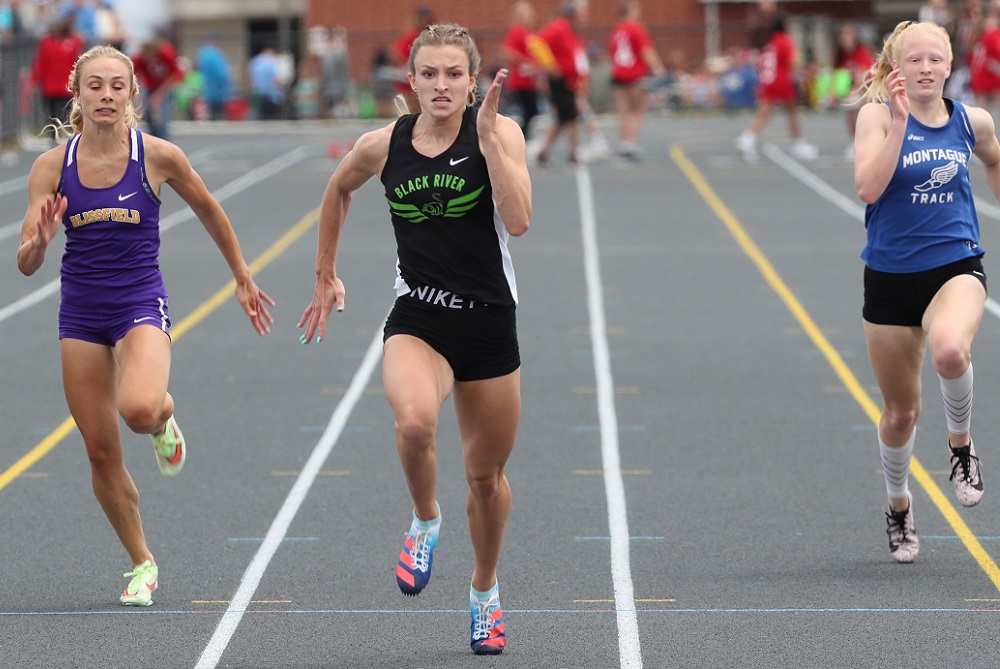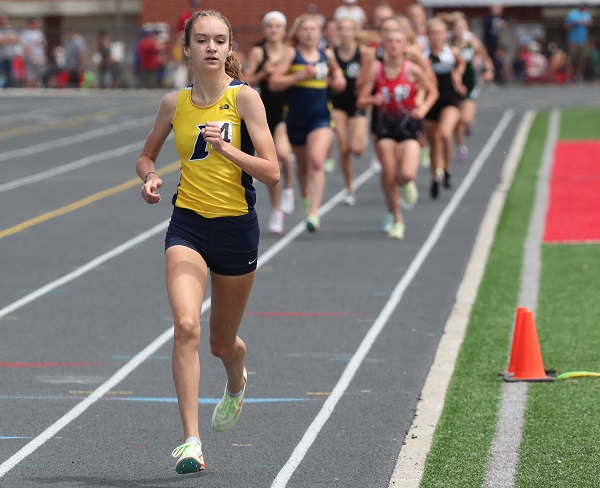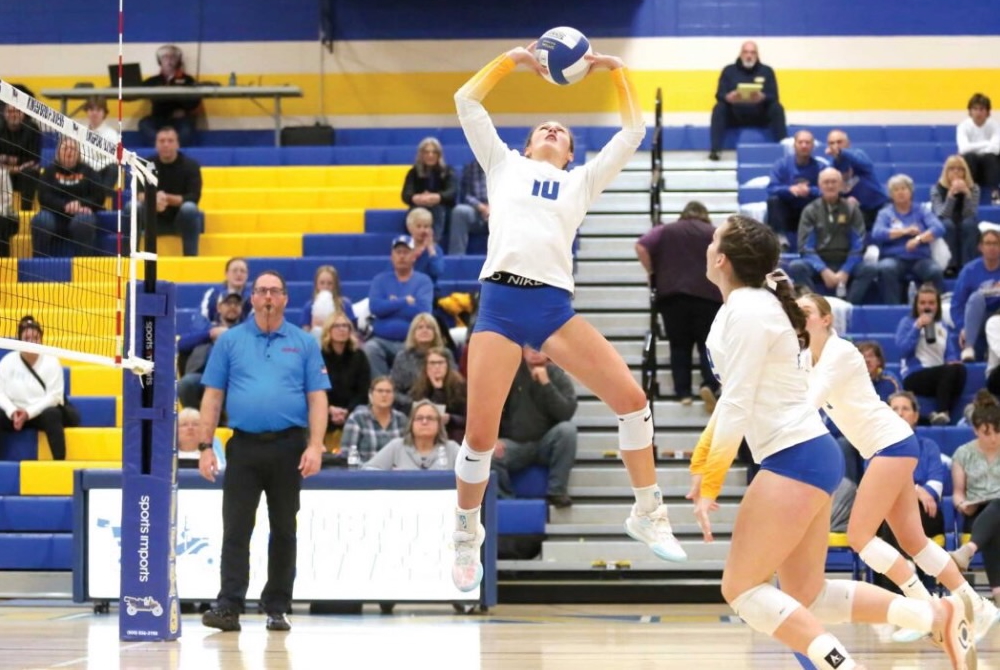
Future Rivals Shine at Kent City, Hart Beats All for 2nd Finals Win
By
Scott DeCamp
Special for MHSAA.com
June 5, 2022
KENT CITY – Kylee Poulton and Lani Bloom are small-school standouts headed for the big time of Division I track & field in the Big Ten Conference.
They showed why at Saturday’s MHSAA Lower Peninsula Division 3 Finals at Kent City High School. They’re about to be arch-rivals in college, too.
Poulton, a Holland Black River senior signed with Indiana University, sprinted to individual titles in the 100-meter dash (12.28 seconds) and 200 (24.83). Bloom, an Ithaca senior signed with Purdue University, ran away with championships in the 800 (2:11.86) and 1,600 (4:49.60). Both runners also anchored relays for their respective teams.
Cross country power Hart was a landslide winner of the team Finals title, the Pirates’ second overall and first since 2018, as they totaled 63 points – 24 more than runner-up Pewamo-Westphalia. Onsted was third (33), Montague fourth (29) and Quincy fifth (28).
“You know, it’s been fun. I know when I started coaching back in ’98 for Hart, they needed somebody and it kind of just grew into a passion. I love coaching – I like teaching school, but I love coaching, too,” said Hart girls track coach Calvin Ackley, who is an assistant for the Pirates’ girls cross country program that’s a five-time reigning champ in LP Division 3.
“It’s fun. It’s fun just to put Hart on the map a little bit in one small aspect of life. … If you’re going to do something, do it all-out, you know.”
All-out is exactly the way Poulton and Bloom performed Saturday.
For Poulton, those were her first two Finals championships. She had the best time of all qualifiers in the 400 but decided not to run that event because she wanted to conserve energy for the 200. Last year, she was LPD3 runner-up in the 100, third in the 200 and fourth in the 400.
Poulton ran the anchor leg on Black River’s 1,600 relay team to close the day Saturday. That quartet did not place, but she still enjoyed herself.
 “This year was really fun. I really love my team this year,” said Poulton, who ran into a bit of a headwind Saturday but still felt strong. “Having a 4x4 relay has been, like, a highlight because it’s just so fun.
“This year was really fun. I really love my team this year,” said Poulton, who ran into a bit of a headwind Saturday but still felt strong. “Having a 4x4 relay has been, like, a highlight because it’s just so fun.
“In the past years, I wasn’t able to participate in relays, but we were able to put together a pretty good team this year and run in the state finals. I’d say my highlight would be the Regional meet. We were last (in the 1,600 relay) and then we ended up becoming first (at the Regional).”
Bloom is no stranger to MHSAA Finals championships. She also won 800 and 1,600 titles at last year’s Finals, plus she captured an LP Division 3 cross country championship in the fall.
Bloom anchored Ithaca’s 3,200 relay team that placed fourth.
“I was really nervous going into (Saturday’s meet) because I haven’t really had a lot of races where I had to have that get-up-and-go mindset where I had to, like, actually race my hardest, dive over the line every time,” she said. “It was a challenge for me today, but I feel like I really rose to the occasion and I’m really proud of what I did today.”
Other individual champions from Saturday’s LP Division 3 Finals included Onsted’s Emmry Ross in the 400 (57.93), Grand Rapids Covenant Christian’s Meghan Beute in the 3,200 (personal record 10:37.57), Pewamo-Westphalia’s Saige Martin in the 100 hurdles (15.23 PR) and 300 hurdles (46.24 PR), Sand Creek’s Grace Elliott in shot put (40-4.25 PR), Grayling’s Rylan Finstrom in discus (145-2 PR), Lawton’s Heidi Newhouse in high jump (5-5), Grand Rapids West Catholic’s Ally Olszewski in pole vault (11-0 PR) and Benzie Central’s Gloria Stepanovich in long jump (17-4.25).
Two of Montague’s relay teams claimed championships, in the 400 (50.24) and 800 (1:47.10). Ross helped Onsted also win the 1,600 relay (4:06.02), while Hart cruised to victory in the 3,200 (9:30.18).
“I mean, it’s crazy. We just came here with nine girls, and we knew we were seeded decently high. But just to go out here and finally do it has been something that I didn’t expect at the beginning of the season,” Hart senior Kendall Williamson said. “I had no idea we were going to be here.”
PHOTOS (Top) Holland Black River’s Kylee Poulton, middle, sets the pace during one of her sprint championships Saturday at Kent City. (Middle) Ithaca’s Lani Bloom builds a significant lead during one of her victories. (Click for more from Carter Sherline/Run Michigan.)

Kingsford's Kreider Prepared for Next Level After Finishing Stellar Flivvers Career
By
John Vrancic
Special for MHSAA.com
June 19, 2025
KINGSFORD — After completing a successful high school volleyball career, Maddy Kreider is ready to take the next step.
 The Kingsford senior is taking her talents to Michigan Tech, where she’s expected to continue primarily as a setter.
The Kingsford senior is taking her talents to Michigan Tech, where she’s expected to continue primarily as a setter.
“That will be a big step for sure, but it’ll be exciting being with the girls,” she said. “The girls are taller in college. It will definitely be an adjustment, physically and mentally. We’ll be traveling longer distances, and it’ll be a matter of improving the mental part of my game.”
Kreider was selected the Upper Peninsula’s Defensive Player of the Year her final two seasons after the U.P. Sportswriters and Sportscasters Association began voting for all-U.P. volleyball.
“That’s quite an accomplishment,” she said. “It’s a real honor playing with girls I grew up with. We had a great season.”
The 5-foot-8 setter was a four-year starter and two-year team captain at Kingsford, leading the Flivvers to three Division 2 District titles and back-to-back undefeated Great Northern Conference championships. She twice was named GNC Player of the Year.
She was also selected all-state first team in the fall and all-state second team in 2023, and all-region throughout her prep career. Her serving percentage also topped .900 throughout her four seasons on varsity.
 Last fall, the Flivvers reached the Regional Semifinal at Manistique where they dropped a 3-2 decision to Kingsley.
Last fall, the Flivvers reached the Regional Semifinal at Manistique where they dropped a 3-2 decision to Kingsley.
“I thought we’d get through,” Kreider said. “We came out lights out in the first two sets, then it was close in the last three.”
Also among the team’s highlights this past fall was a victory at Calumet, approximately 2½ weeks after dropping a 3-1 decision to the Copper Kings on Kingsford’s home floor.
“We wanted to play them,” Kreider said. “They’re a great bunch of girls to play against. They’ve been the measuring stick up here for many years. Winning on their floor was super exciting. We knew we had to play well just to be competitive. That was a great confidence builder for our group. We were definitely on a high going into the District.”
The Flivvers opened their postseason with a 3-1 triumph over Houghton, then defeated Escanaba in straight sets in the District Final.
Kreider will join Calumet senior Maddie Torola at MTU this fall. Torola, who recorded a season-high 19 kills in the four-set victory at Kingsford, helped the Copper Kings finish 29-5 and reach the Division 3 Regional Final at Sault Ste. Marie where they dropped a 3-2 decision to Traverse City St. Francis.
“It was fun playing against her in high school,” Kreider said. “It will be even more fun playing as teammates. It’ll be exciting to be playing on the same team.”
Both will be playing under new head coach Cindy Pindral at Tech. Both of Kreider’s parents played for the Huskies, her mother (and Kingsford varsity coach) Jaclynn volleyball from 1998-2002 and her father Jason basketball from 1997-2000.
Maddy Kreider recently earned an additional honor when she was selected Female Athlete of the Year for Kingsford’s Class of 2025. She recently completed a solid track & field season for the Flivvers.
At the U.P. Division 1 Finals, Kreider placed fourth in the 100-meter dash (13.2) and anchored the Flivvers to a third-place finish in the 800 relay (1:51.57) and fourth in the 400 (53.03) on their home track.
Kreider was named one of 32 MHSAA/Farm Bureau Insurance Scholar-Athlete Award winners this winter and plans to study exercise science and kinesiology at MTU.
 John Vrancic has covered high school sports in the Upper Peninsula since joining the Escanaba Daily Press staff in 1985. He is known most prominently across the peninsula for his extensive coverage of cross country and track & field that frequently appears in newspapers from the Wisconsin border to Lake Huron. He received the James Trethewey Award for Distinguished Service in 2015 from the Upper Peninsula Sportswriters and Sportscasters Association.
John Vrancic has covered high school sports in the Upper Peninsula since joining the Escanaba Daily Press staff in 1985. He is known most prominently across the peninsula for his extensive coverage of cross country and track & field that frequently appears in newspapers from the Wisconsin border to Lake Huron. He received the James Trethewey Award for Distinguished Service in 2015 from the Upper Peninsula Sportswriters and Sportscasters Association.
PHOTOS (Top) Kingsford’s Maddy Kreider sets for her teammates during a match last season. (Middle) Kreider, right, takes a photo with Kingsford’s Male Athlete of the Year Gavin Grondin. (Photos provided by the Kingsford athletic department.)

